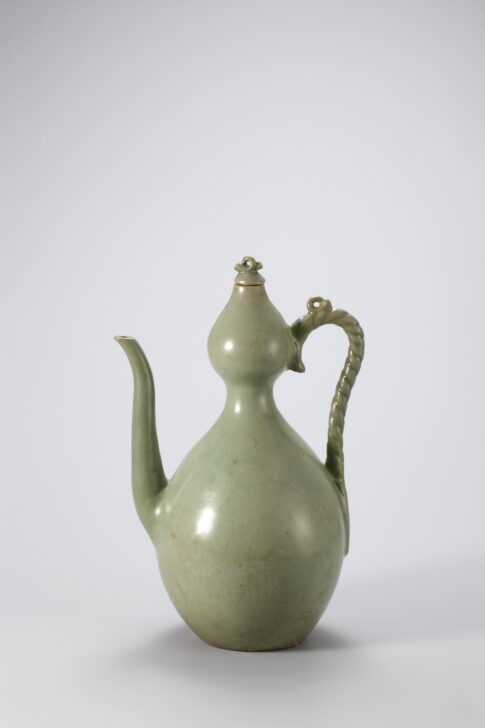Double-Gourd Ewer with Lid
Korean

Description
March 28, 2009
Under royal patronage, Buddhist monasteries in the Goryeo period flourished and accumulated vast tax-free estates. Many royal sons became Buddhist monks, and a rarified culture of tea and wine drinking developed between court and monastery. The kilns that made the exquisite celadon tea bowls, wine cups, and ewers for this elite class were located in Buan, North Jeolla Province, and Gangjin, South Jeolla Province.
Goryeo ewers were frequently inspired by plant forms, such as melons, bamboo shoots, and gourds. This ewer is modeled on the calabash, or double gourd, which is still used in Korea to form ladles. The imagery extends to the ewer’s handle, which is braided to simulate the twisted tendrils of the gourd. A cord attached to the loops on the handle and the lid kept the stopper at hand. The closed vessel form, with only small openings for filling and pouring, is particular to Goryeo ceramics. The lid, spout, and handle are later restorations.
(Label for UMMA Korean Gallery Opening Rotation, March 2009)
Subject Matter:
An ewer in the shape of a calabash, or double-gourd.
Physical Description:
Stoneware ewer with celadon glaze in the shape of a calabash, or double-gourd. The handle mimics the tendrils of the gourd. A long, thin spout curves slightly outward from the rounded base, and a small lid crested by a tendril-like loop covers an opening at the top of the ewer.
This is an undecorated gould-shaped ewer. Its stopper, handle joints, handle, and spout show traces of repair and restoration. The at base retains four refractory spur marks and was glazed only in the center of the outer base. The glaze was not fused well in parts, leaving some runnings, but it is well balanced in form.
[Korean Collection, University of Michigan Museum of Art (2014) p.132]
Usage Rights:
If you are interested in using an image for a publication, please visit https://umma.umich.edu/request-image/ for more information and to fill out the online Image Rights and Reproductions Request Form.